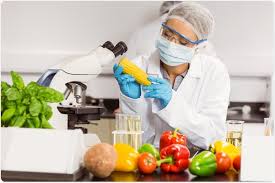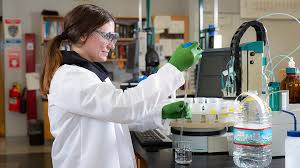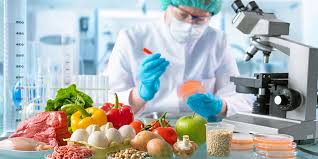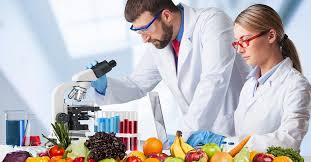Food is a complex biochemical material that satisfies appetite, supports growth, maintains body processes, and supplies energy. From a professional standpoint, food is any substance whether processed, semi-processed, or raw intended for human consumption, which includes drinks and substances used in food preparation.
This does not cover cosmetics, tobacco, or substances used solely as drugs. Since foods vary significantly in the nutrients they contain, they are classified based on their composition and origin.
A normal healthy diet should not only consist of the three major nutrients: fat, carbohydrates, and protein, but should also provide essential macro- and micronutrients, such as dietary fiber, minerals, and vitamins.
i. Micronutrient: A nutrient needed in small amounts, essential for growth and development, e.g., vitamins and minerals.
ii. Macronutrient: Elements needed in large amounts for normal growth and development.
For good health, a range of micronutrients is required in sufficient quantities, with the absence of toxic components, whether naturally present or as contaminants. Food Science and Technologists apply their scientific knowledge to ensure food reaches consumers in the best possible state.
Read Also: Agricultural Tillage Practices
Definition of Food Science

Food Science studies the physical, biological (including microbiological), and chemical makeup of food. Food Scientists and Technologists use scientific disciplines like Chemistry, Engineering, Microbiology, Epidemiology, Nutrition, and Molecular Biology to improve the safety, nutrition, wholesomeness, and availability of food. Based on their specialization, Food Scientists develop methods to process, preserve, package, and store food, adhering to industry and government specifications.
Misconceptions about Food Science
1. Food Science is not Nutrition: While food scientists may work on making foods more nutritious or determining health benefits, Nutrition and Food Science are distinct fields.
2. Food Science is not Cooking: Food Scientists focus on safety and nutrition, not just taste, unlike chefs who aim to create pleasing dishes.
3. Food Science is not Food Service: Food Scientists are involved in food safety and product development, unlike those seen in restaurant service roles.
Scope of Food Science and Technology

1. Food Chemistry
Food Chemistry involves studying the composition of foods, their properties, and how they interact with each other and their environment. It also covers Food Analysis, which includes qualitative (identifying unknown components) and quantitative (measuring component amounts) analysis. The main food components include proteins, carbohydrates, fats, minerals, and vitamins. Here are some key reactions in food chemistry:
i. Proteins: Protein hydrolysis produces polypeptides, peptides, and amino acids. Polypeptides can be broken down by peptidases into simpler peptides and amino acids, contributing to both desirable and undesirable flavors. Anaerobic breakdown of proteins leads to foul-smelling sulfur- and nitrogen-containing products, such as ethyl sulfides and ammonia (putrefaction).
ii. Carbohydrates: Glucose undergoes different forms of fermentation and oxidation, resulting in carbon dioxide, water, ethanol, organic acids, and energy. Oxidation reduces acidity and increases susceptibility to microbial attack.
iii. Fats: Microbes can break down fats into glycerol and fatty acids. Understanding these reactions is essential for delivering safe, nutritious, and tasty foods.
2. Food Microbiology
Food Microbiology focuses on the study of microorganisms, such as bacteria and fungi, and their impact on food systems.
i. Bacteria: They play dual roles—causing spoilage and foodborne diseases but also enhancing flavor and nutrition in fermented foods like yogurt and cheese.
ii. Fungi: Fungi, including molds like Aspergillus niger, decompose organic matter and have applications in medicine and food manufacturing. Yeasts, like Saccharomyces cerevisiae, are used in fermentation processes and as sources of vitamins and enzymes.
3. Food Packaging
Food packaging plays a critical role in maintaining food quality by protecting it from environmental conditions, contaminants, and physical or chemical changes. The choice of packaging material depends on the type of food and processing method.
For example, oils are packaged in oxygen-impermeable containers to prevent rancidity, while oxygen-permeable wraps are used for fruits and vegetables. Packaging materials include metal, glass, plastic, and paper, each with advantages and limitations.
4. Food Processing and Preservation
Food Processing encompasses the steps food undergoes from harvest to retail, transforming raw materials into different forms, like oil from soybeans or cheese from milk.
5. Food Preservation
Food Preservation refers to techniques used to prevent spoilage. These methods ensure the availability of food year-round by extending shelf life and making products convenient for consumers. Combining modern processing and preservation techniques with efficient distribution networks ensures a consistent food supply.
6. Food Distribution and Marketing
Food Distribution involves transporting processed and packaged food to retail outlets. Modern transportation and refrigeration methods enable even perishable foods to be delivered over long distances. The distribution network plays a vital role in ensuring the availability of foodstuffs, even in remote areas. Retailers can buy food directly from processors or through wholesalers, cooperatives, or brokers.
7. Food Situation in Nigeria
Nigeria relies heavily on subsistence farming, producing crops like sorghum, millet, maize, rice, yams, and cassava, along with poultry, goats, and sheep. Although agriculture accounts for 26% of Nigeria’s GDP, food production is seasonal, leading to shortages and wastage during off-peak periods. Losses in food produce can be as high as 25–65% in perishable items like plantains and tomatoes.
Food spoilage and wastage are compounded by inadequate processing, preservation, and storage facilities. Improved techniques could drastically reduce food losses and enhance food security. The establishment of specialized food processing plants close to farming areas could provide solutions by producing wholesome food that meets government standards.
Read Also: Maggot Feeding: Can You Feed Fishes with Maggots?
Role of Quality Control in Food Production

Quality control ensures food products meet safety and regulatory standards. The National Agency for Food Drug Administration and Control (NAFDAC) in Nigeria plays a crucial role in setting standards to prevent adulteration, control chemical use, and ensure the production of safe food. However, challenges remain in enforcing these regulations, especially among small-scale industries.
Modernization of Food Technology in Nigeria
To address Nigeria’s food challenges, modernization of traditional food processing techniques is essential. Developing improved methods for producing indigenous foods like garri and ogi will help preserve cultural heritage and reduce dependency on foreign products. Modernizing native technology will ensure Nigeria can overcome its food security challenges while providing nutritious and safe food for its growing population.
Do you have any questions, suggestions, or contributions? If so, please feel free to use the comment box below to share your thoughts. We also encourage you to kindly share this information with others who might benefit from it. Since we can’t reach everyone at once, we truly appreciate your help in spreading the word. Thank you so much for your support and for sharing!
Read Also: Measurement and Definition of the term water yield

